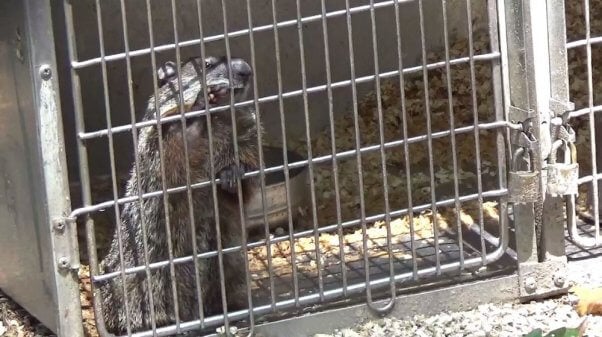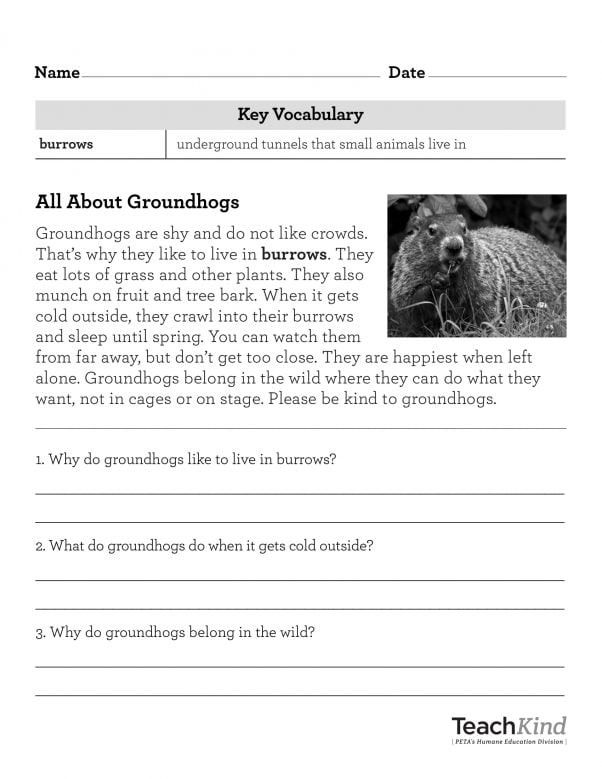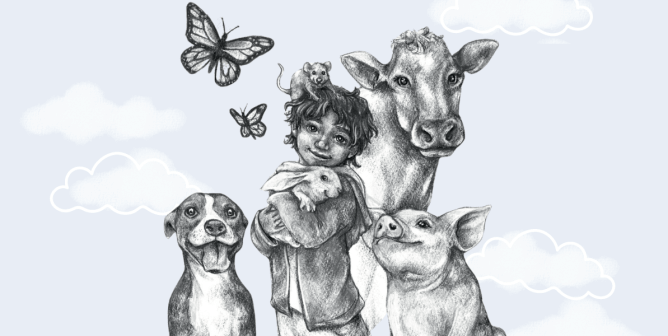This Groundhog Day, Say No to Cruel Holiday Displays
Groundhogs are naturally shy, sensitive prey animals who react poorly when handled in front of raucous crowds, as evidenced by a 2015 incident in which a groundhog named Jimmy bit a Wisconsin mayor’s ear at the 67th annual Sun Prairie Groundhog Day celebration.
Punxsutawney Phil, the groundhog used for a Groundhog Day celebration in Pennsylvania every year, is forced to be on display year round at the local library and is denied the opportunity to prepare for and enter yearly hibernation. Not only do events at which groundhogs are handled pose a risk to the animals and their handlers, they could also trigger stress-induced disorders in animals who aren’t outwardly harmed.
Rather than perpetuating this cruel holiday tradition, teach your students compassion for animals and interesting facts about groundhogs with TeachKind’s “All About Groundhogs” reading comprehension worksheet. Your students will love reading about these interesting animals and learning why they deserve freedom and respect—not to be used as ceremonial props.
Download TeachKind’s “All About Groundhogs” reading comprehension worksheet.
Before Reading
Begin by explaining to your students the cruel tradition of Groundhog Day. Tell them that many groundhogs are taken away from the safety and comfort of their natural habitat and kept in roadside zoos and museum exhibits—where they can’t search for food, roam freely, or even hibernate for the winter—all so that people can hold them up in front of large, loud crowds to find out if the animals will “see their shadows.” Superstition suggests that if the groundhogs see their shadow, there will be six more weeks of cold wintry weather, and if they don’t, warm spring weather will arrive early. Living in poor conditions can cause wild animals to become distressed, sad, and even sick, which is why people should never visit roadside zoos, marine parks, or any other place that uses animals for entertainment.
During Reading
Have students read the short passage, which is ideal for those in grades K–2, to themselves, or have them follow along on their worksheet as you read the text aloud, posing the following questions to promote empathy for all living beings:
- How do you think groundhogs used in holiday displays feel when they’re held up in front of a crowd of people? Why? (Possible answer: They feel scared and uncomfortable because they’re shy animals and don’t like crowds.)
- Why do you think groundhogs are happiest when people leave them alone? When are you happiest? (Possible answer: They’re shy and don’t like crowds. Additional answers will vary.)
- Why do groundhogs belong in their burrows in the wild? (Possible answer: That’s their home.)
- How can you be kind to groundhogs? (Possible answer: Watch them from far away, leave them alone, let others know that they don’t like to be in cages or on a stage in front of crowds.)
After Reading
Have students answer the comprehension questions below the passage in complete sentences, either in writing or verbally, and then discuss them as a class. Remind students that the tradition of Groundhog Day isn’t just cruel but also inaccurate: Whether the groundhogs “see their shadows” or not doesn’t determine when warm weather will arrive. Instead of encouraging students to participate in inhumane and superstitious holiday spectacles, offer these fun alternatives:
- Use a farmers’ almanac to predict seasonal weather.
- Count down the days until the spring equinox.
- Keep track of daily outdoor temperatures on your classroom calendar. Use a red marker or sticker to indicate days on which the temperature increased and a blue marker or sticker to indicate days on which it decreased. At the end of each week, have students determine whether there were more “red” or “blue” days.
- Invent a fun tradition of your own! Have students look for animals often seen in the spring—like ducks and rabbits—in their neighborhoods, or plant seeds and note when they sprout as a signal of the return of warm weather.

Want more holiday-related content? Sign up for TeachKind News!
By submitting this form, you’re acknowledging that you have read and agree to our privacy policy and agree to receive e-mails from us.







